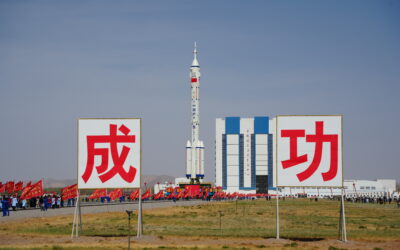
Russia’s Response to U.S. Aid: Shrugs, Disinformation and Warnings of Nuclear War
SUBSCRIBER+ EXCLUSIVE REPORTING — Russia’s reaction to the new infusion of U.S. aid for Ukraine has ranged from shrugs to fury, from warnings of nuclear […] More
Bottom Line Up Front
China has created a highly-controlled environment in Xinjiang, a province in the country’s northwest that borders Central Asia, where it monitors minority ethnic Uighurs, relying on emerging technologies to track and surveil them. Using artificial intelligence (AI), biometrics and a range of other high-tech gadgetry, China’s internal security apparatus closely surveils various segments of its domestic population. China already has over 200 million surveillance cameras and plans to use AI to help track the movements of its population, as well as to monitor the internet usage, travel, and personal communications of its citizens.
The Chinese Communist Party (CCP) cites widespread religious extremism as the motivating force behind terrorist activity in China and the primary reason behind this draconian counterterrorism strategy. China has detained at least one million Uighur Muslims in Xinjiang and other parts of northwest China, although some estimates are three times as high. The stated claim of the authorities is that these detention camps, or what Chinese officials have referred to as vocational training centers, will help to ‘purge ideological diseases,’ by which they mean religion. China has insisted its camps seek to achieve ‘transformation through reeducation,’ but the primary ideological thrust is about diluting the influence of Islam in Uighur communities. Mosques are monitored and every hundred yards, checkpoints are staffed by armed police. Officials have banned ‘abnormal beards,’ Islamic names for children, and fasting during the day throughout the Muslim holy month of Ramadan in what many see as counterproductive actions likely to provoke a backlash among the population.
The Chinese government is calculating that even if its actions do breed resentment, the security state that has been so carefully constructed will be sufficient to crush all dissent. The methods have increasingly grown harsher over the past several years. Citizens are required to swipe official identification cards and security forces maintain vast biometric profiles in electronic databases. Compulsory software is downloaded on phones and satellite navigation systems are installed in vehicles. With handheld devices, Chinese security personnel can scan the phones of citizens to search for encrypted communications or any content, especially videos, considered to be extremist in nature by the government. Surveillance cameras are ubiquitous, but the efforts to control the population may expand further into other aspects of daily life. China’s social credit scoring system will also be driven by AI and will seek to expand ‘social-style scores’ that evaluate citizens’ behavior and ‘trustworthiness,’ which will directly affect access to credit or interfere with the ability to purchase items like plane tickets.
China could seek to extend its influence globally through highly invasive technology incorporated into its Belt and Road Initiative (BRI), collecting and analyzing data of allies and adversaries alike. China is dispensing capital throughout BRI according to what some have labeled ‘extortionist terms’ and through providing incentives, which also serves to enable access for its technology. The advent of 5G and the role of Huawei is a major concern for the U.S. It will likely affect the continuation of the sharing of intelligence with allies that choose to rely on Huawei as the backbone of future tech infrastructure. Of further concern is that China’s high-tech counterterrorism apparatus could appeal to other autocrats, especially those battling active insurgencies. There is a palpable fear in the West that China could seek to export its counterterrorism model to other authoritarian regimes, which would use technology to harass and control minority populations.
Related Articles

SUBSCRIBER+ EXCLUSIVE REPORTING — Russia’s reaction to the new infusion of U.S. aid for Ukraine has ranged from shrugs to fury, from warnings of nuclear […] More

SUBSCRIBER+ EXCLUSIVE REPORTING — When Chinese President Xi Jinping came to San Francisco last November to meet with President Joe Biden, Chinese pro-democracy activists in […] More

SUBSCRIBER+EXCLUSIVE EXPERT PERSPECTIVE — More than two years after its withdrawal from Afghanistan, the U.S. still does not have a clear way forward in the […] More

SUBSCRIBER+ EXCLUSIVE REPORTING — Ukrainians greeted Saturday’s long-awaited House passage of $60.8 billion in aid with justifiable jubilation. For months, their soldiers, civilians, and political […] More

SUBSCRIBER+ EXCLUSIVE REPORTING — A race for control of space is underway, and just as on earth, the U.S. and China are the top competitors. […] More

SUBSCRIBER+ EXCLUSIVE REPORTING — For nearly a week, the Middle East and much of the world were on a knife’s edge, waiting for a promised […] More
Search